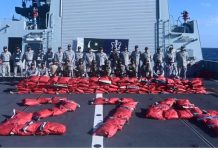WASHINGTON: Days before the Trump administration suspended US security assistance to Pakistan, the country launched a new factsheet, showing how terrorism has killed more than 74,000 people over the last 14 years and cost $123 billion in economic losses.
The report, however, had little impact on the US political discourse, which has become increasingly hostile to Islamabad since 2011 when Osama bin Laden was discovered and killed in Abbottabad.
The document re-emphasises Pakistan’s stance that the death of 122 children at a Peshawar school on Dec 16, 2014, was a watershed moment, which galvanised the entire nation against terrorism and the operations launched since then have targeted all terrorists, without any exception.
The booklet also details Pakistan’s counter-terrorism efforts and shows how it has forced terrorists to escape to their hideouts or flee across the border to Afghanistan.
It specifically highlights the sacrifices of the Pakistani armed forces and civilian security forces in restoring normalcy to the country in general and the Federally Administered Tribal Areas (Fata) in particular.
 The booklet previews the progress made under each of the 20 points of the National Action Plan (NAP) and underlines the nation’s determination to defeat terrorism.
The booklet previews the progress made under each of the 20 points of the National Action Plan (NAP) and underlines the nation’s determination to defeat terrorism.
A similar report by the International Physicians for the Prevention of Nuclear War places the number at 48,504 deaths Pakistan suffered while fighting militants between 2003 and 2015.
And the Global Terrorism Index (GTI) shows a marked decline in terrorism-related violence in Pakistan since 2014, partially due to military operations targeting militants in tribal areas and acknowledges that Pakistan has made a major stride in curbing terrorism.
Neta C. Crawford, the author of a study — “Update on the Human Costs of War for Afghanistan and Pakistan, 2001 to mid-2016” — released in November 2017, endorses Islamabad’s claim that the war in Pakistan “began as Al Qaeda and the Taliban fled from Afghanistan into the northwest region of Pakistan in 2001”.
She also notes that Pakistan’s losses remain underreported, showing how the estimates of losses in drone attacks range from a low of 158 civilian deaths to a high of 2,657.
She also endorses another Pakistani claim that “increased intensity of the fighting in Afghanistan could have a spillover effect in Pakistan”.
The report notes that more than one million people were displaced in the 2014 anti-militant operation in North Waziristan.
The estimates include: 22,100 civilian deaths and 40,792 injuries and 8,214 deaths in the security forces between 2001 and 2015.
About 31,000 Taliban and other militants were also killed. Fifty-eight journalists and 92 humanitarian workers also died.
Some of these statistics showed up in statements by senior US leaders — from President Donald Trump and his cabinet members to spokespersons for various departments.
In his latest statement, US Defence Secretary James Mattis conceded that “Pakistan has lost more troops total than all of Nato coalition combined in the fight against them,” a fact also highlighted by Secretary of State Rex Tillerson.
But in most cases, those statistics were used as a prelude to spur Pakistan to accept the US demand for taking a decisive action against the Haqqani network and other members of the Afghan Taliban.
Marvin Weinbaum, a prominent US scholar of South Asian Affairs, sees a “disconnect” between the Pakistani narrative and the general discussion on Pakistan in US official circles, NGO circuits and the media.
“The message does not get across,” said Mr Weinbaum while talking to a group of Pakistani journalists after the launching ceremony where almost 90 per cent of the participants were from the Pakistani American community.
The embassy tries its best to project Pakistan’s point of view in influential circles — the administration, Congress, media and NGOs included — but does not seem to have made the impact that could persuade people to listen to the Pakistani side of the story.
This is apparently also because the negative images and stories from Pakistan dominate the US media and they are reported with an angle that cannot generate much sympathy for Pakistan.
The embassy also seems to focus more on projecting its efforts in the Pakistani media.



